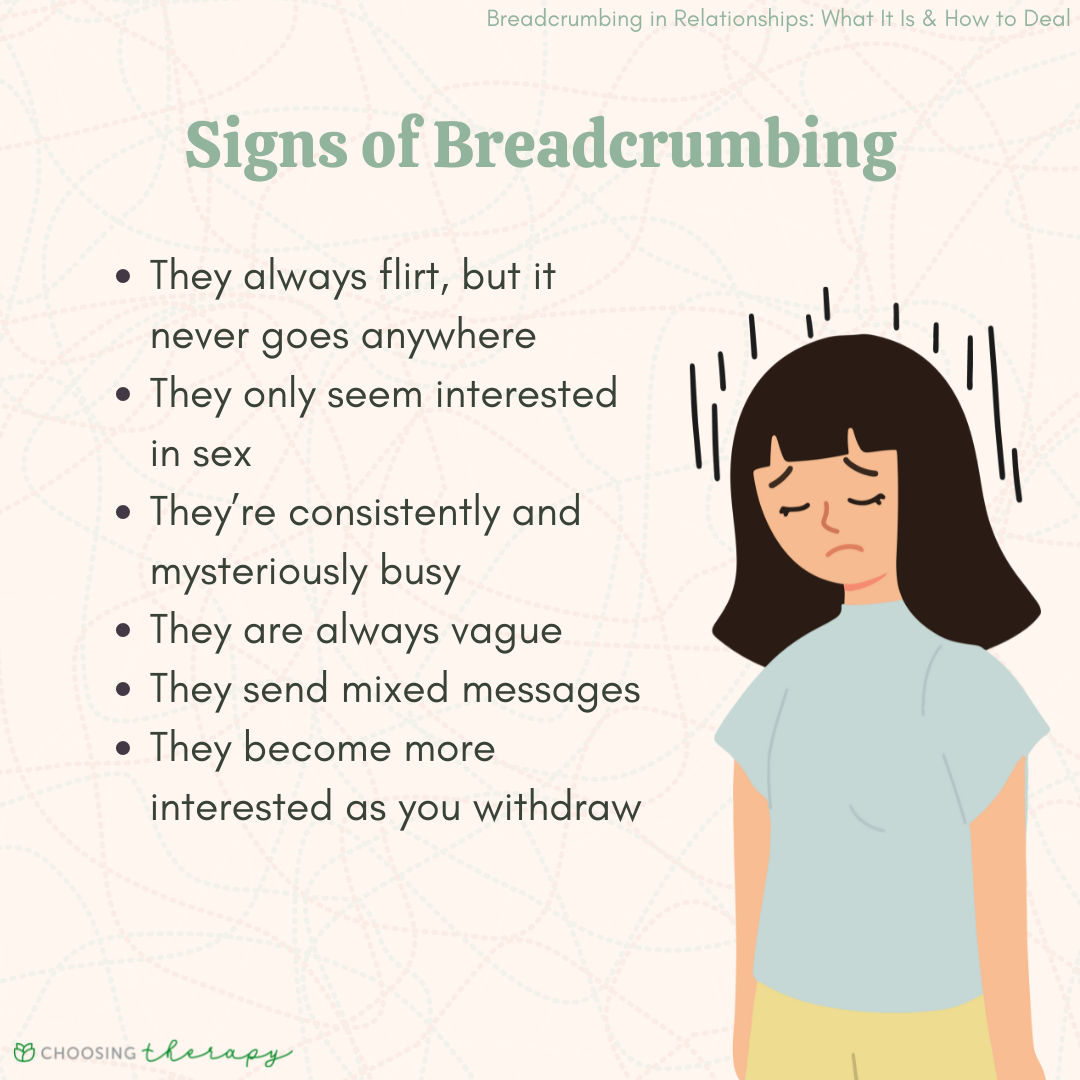Breadcrumbing is a modern dating behavior characterized by sending intermittent, minimal, or ambiguous signals of romantic or sexual interest, such as occasional texts, social media likes, or vague invitations, without the intention of progressing toward a committed relationship. The term draws metaphorically from the act of dropping breadcrumbs to lead someone along a path, but in this context, it reflects a pattern of engagement designed to maintain the other person’s attention or emotional investment without meaningful follow-through.
Breadcrumbing
| |
|---|---|
| Full Name | Breadcrumbing |
| Core Characteristics | Inconsistent communication, lack of commitment, emotional ambiguity |
| Typical Medium | Text messages, dating apps, Instagram likes, DMs, intermittent replies |
| Motivations | Validation, ego-boosting, keeping options open, fear of confrontation |
| Emotional Impact | Frustration, confusion, lowered self-esteem, emotional exhaustion |
| Associated Traits | Passive communication, avoidance of intimacy, attention-seeking |
| Contrasts With | Ghosting, direct rejection, emotionally available communication |
| Associated Disciplines | Dating psychology, interpersonal communication, digital culture |
| Clinical Relevance | Breadcrumbing can trigger attachment anxiety or reinforce insecure patterns |
| Sources: Barry et al. (2008), LeFebvre & Allen (2020) | |
Other Names
Lead-on texting, romantic stringing, casual baiting, digital flirting trail, slow-burn manipulation, intermittent reinforcement dating
Origins and Popular Usage
The term breadcrumbing emerged in the mid-2010s as part of a wave of internet slang used to describe ambiguous or manipulative online dating behaviors. While not a clinical diagnosis, the term is widely recognized in relationship blogs, dating forums, and psychology-adjacent media. It parallels concepts like intermittent reinforcement in behavioral psychology, where inconsistent rewards (such as occasional attention) increase emotional dependency.
Psychological Mechanisms
Digital disappearance strategies operate by:
- Maintaining the target’s emotional availability without emotional reciprocity
- Creating hope through minimal engagement (think: “Hey Bighead”, “Hey stranger” texts, likes without messages)
- Avoiding responsibility or emotional labor while keeping the option open
This behavior can be especially damaging to individuals with anxious or preoccupied attachment styles, who may be particularly sensitive to ambiguous romantic signals.
Neurobiology of Breadcrumbing
Breadcrumbing behavior and the emotional responses it provokes can be partially understood through the lens of social neuroscience. Both individuals who engage in casual baiting and those affected by it exhibit patterns of behavior that map onto well-established brain circuits involved in reward, emotional regulation, attachment, and social pain.
Dopaminergic Reward Circuits
The brain’s reward system, particularly the mesolimbic pathway involving the ventral tegmental area (VTA) and nucleus accumbens, plays a central role in casual baiting dynamics. When attention or communication is delivered inconsistently, it activates the variable ratio reinforcement schedule a pattern known to strongly stimulate dopamine release. This makes the intermittent contact feel more rewarding than predictable communication, reinforcing attachment to the person casually baiting. The same reward mechanisms are engaged in behaviors like gambling and compulsive social media use.
Anterior Cingulate Cortex (ACC)
The anterior cingulate cortex is involved in processing emotional pain, particularly the distress of social rejection or exclusion. fMRI studies have shown that the ACC is activated when individuals experience social pain such as waiting for a response that never comes, or receiving mixed signals. Breadcrumbing, by design, creates this kind of ambiguity and emotional uncertainty, thereby engaging the same neural substrates activated by physical pain.
Prefrontal Cortex (PFC)
In the individual doing the breadcrumbing, the prefrontal cortex, especially the ventromedial and dorsolateral regions, regulates impulse control, planning, and social decision-making. Dysfunction or underactivation in these areas may contribute to emotionally avoidant or manipulative behavior. Insecurely attached individuals may rationalize casual baiting as a way to maintain autonomy while preserving options, often without fully processing the emotional consequences for others.
Amygdala
The amygdala, a central structure in the limbic system, plays a key role in detecting social threat and ambiguity. Individuals on the receiving end of casual baiting may experience heightened amygdala activation due to relational unpredictability. This can lead to increased vigilance, anxiety, and overinterpretation of minimal cues (e.g., reading too much into a short text), especially in those with anxious attachment styles.
Oxytocin and Attachment Circuits
Oxytocin, a neuropeptide involved in bonding and social memory, is also implicated in breadcrumbing dynamics. In securely attached individuals, oxytocin release fosters trust and emotional regulation. However, in those with insecure attachment or anxious attachment, oxytocin responses may be dysregulated. The resulting bond to an inconsistent or emotionally unavailable person can feel disproportionately intense, reinforcing maladaptive connection patterns even when the relationship lacks reciprocity.
Concrete Examples of Breadcrumbing
Breadcrumbing behaviors can be subtle or overt, but they typically involve minimal effort used to maintain another person’s emotional interest without commitment or progression. These behaviors are common in digital dating environments but can also occur in offline interpersonal dynamics. Below are several concrete examples that illustrate the spectrum of casual baiting behaviors:
Texting Breadcrumbs
- Occasional “Hey stranger” texts sent at random intervals, often without follow-up conversation
- Liking Instagram or TikTok posts after weeks of no meaningful communication, without messaging directly
- Replying with emojis or one-word responses that convey vague interest but no conversational depth
- Sending a DM that says “we should hang out soon” but never following through with plans
- Commenting “🔥” or “😍” on stories without initiating any private or personal connection
Breadcrumbing on Dating Apps
- Matching on a dating app and messaging sporadically over weeks or months without setting a time to meet
- Ghosting for days, then returning with a casual “what’s up?” as if no time had passed
- Keeping someone active in the chat queue while clearly prioritizing other matches
In-Person Casual baiting
- Flirting in group settings but never showing interest one-on-one
- Promising to make plans (e.g., “Let’s grab drinks soon”) but canceling or going silent before confirming
- Touching base randomly (e.g., birthdays, holidays) just enough to stay emotionally relevant
- Talking about “someday” plans without taking concrete action toward them (e.g., “We should travel together!” with no follow-up)
Emotional Breadcrumbing
- Offering deep compliments or flirtation during moments of vulnerability, then retreating emotionally
- Claiming emotional connection without ever defining the relationship or clarifying intentions
- Showing jealousy or possessiveness if the other person pulls away while still avoiding commitment
These examples highlight the inconsistency and ambiguity central to breadcrumbing. The behavior thrives on maintaining the recipient’s hope or emotional investment, while the person breadcrumbing avoids the vulnerability and responsibility of a reciprocal relationship.
Distinctions from Similar Terms
- Breadcrumbing vs. Ghosting: Ghosting involves complete disappearance, while breadcrumbing maintains intermittent engagement
- Breadcrumbing vs. Benching: Benching implies putting someone on hold but with clearer awareness; breadcrumbing is typically vaguer and more passive
- Breadcrumbing vs. Slow Fading: Breadcrumbing may continue indefinitely without resolution, whereas slow fading leads to gradual disengagement
FAQs
Is breadcrumbing intentional?
Often yes, but not always maliciously. Some individuals may be unaware of the psychological impact of their inconsistent behavior. Others may breadcrumb strategically to maintain emotional control or validation.
Why do people breadcrumb?
Common motivations include fear of commitment, desire for attention or validation, emotional immaturity, or a lack of interpersonal awareness.
How should I respond to breadcrumbing?
Set clear boundaries. Ask for clarity or express your need for consistent engagement. If the behavior continues, disengagement may be the healthiest response.
Is breadcrumbing emotionally abusive?
While not always abusive in intent, breadcrumbing can have emotionally manipulative effects, especially when it exploits someone’s hope or attachment vulnerabilities.




